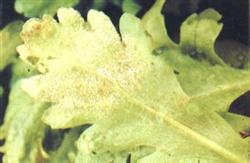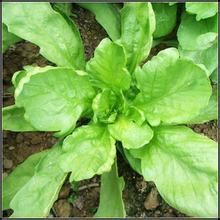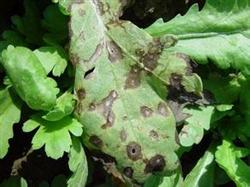Cultivation and pest control techniques of Artemisia annua L.

First, cultivation techniques 1. Select the fields with fertile, loose, good water and fertilizer conservation and convenient drainage and irrigation. two。 The varieties of Artemisia annua can be divided into two types: large-leaf varieties and small-leaf varieties, and small-leaf varieties are mainly selected for greenhouse cultivation. Leaflet varieties are more cold-tolerant, the growth period is 40-50 days. 3. Sowing method 3.1 soak the seeds for 24-28 hours before sowing, remove them and put them in the environment of 15-20 ℃ to accelerate germination, keep moist, and rinse once a day. 3.2After ploughing and fine finishing, the planting field is made into a border with a width of 1-1.2m and a length of 10-15m, with 3500-4000 kg of rotten barnyard manure per mu and 15-20 kg of ternary compound fertilizer as base fertilizer. 3.3 planting methods can be either strip sowing or sowing. The row spacing of strip sowing is 8-10 cm, the sowing area is 5-6 cm, and the amount of seeds used per mu is 2.5-3 kg. It can also be sowed on demand, with a density of 3.5 cm and a seed consumption of 0.85 kg per mu. After sowing, cover 1 cm of soil, and cover the plastic film, after emergence, remove all the plastic film. 4. Field management to keep the border surface dry and wet, 1-2 true leaf stage, inter-seedling and pull out weeds, keep the distance between seedlings about 4 cm. Pay attention to often observe the humidity in the shed to avoid excessive moisture. The first topdressing of urea was carried out in 4 true leaves of the plant, and the second fertilizer was applied in 8-10 true leaves and 7.5-10 kg urea per mu. About 40 days after sowing, it can be harvested when the seedling is about 15 cm high, and can be cut with a knife, scissors or pinched by hand. 1-2 days after harvest, 7.5 kg urea per mu was applied to promote the blooming of lateral branches. After that, it will be harvested every 20 days or so until it blossoms. 2. Pest control techniques the common diseases and insect pests are leaf blight, downy mildew, brown spot, leaf miner, whitefly, aphid and so on. Prevention of diseases and insect pests should be given priority. Comprehensive measures such as strengthening field management, doing a good job of pastoral cleaning and selecting disease-resistant varieties should be adopted, and chemical control should choose pesticides with high efficiency, low toxicity and low residue. Leaf blight can be sprayed with 1500 times of 50% prohydantoin wettable powder or 1500 times of 50% carbendazim wettable powder and used alternately. Downy mildew can be sprayed with 64% disinfectant alum wettable powder or 75% chlorothalonil wettable powder 500 times. Brown spot can be sprayed with 80% Dasheng wettable powder 500 times or 78% Cobo wettable powder 500 times. Usually spray once every 7-10 days, and spray 2-3 times in a row. Leaf miners can be sprayed with 2.5% cypermethrin, or 4.5% cypermethrin 2000 times, or 0.9% mik 1500-2000 times, or 1.8% mik 3000-4000 times. Aphids can be sprayed with 1000-2000 times EC of 10% aphid lice or 4.5% cypermethrin 1500 times to control whitefly. Stop taking medicine 15 days before harvest.
- Prev

High-yield cultivation techniques of Artemisia annua L. in greenhouse
Artemisia annua is an annual green leafy vegetable of Compositae. Its cultivation techniques are as follows: 1. It is best to choose sandy loam for soil preparation and cultivation of Artemisia annua, which requires convenient irrigation conditions. After selecting the land, ploughing and ploughing, and apply a small amount of dried manure as basic fertilizer, mixed evenly with the topsoil layer to make a flat bed 1.4 to 1.5 meters wide.
- Next

Artemisia annua L. and its cultivation techniques in greenhouse
The gray spot of Artemisia annua is a fungal disease, which produces round and near-round spots on the leaves, which are semicircular or irregular at the edge of the leaves. The lesion is 2Mel 4mm in diameter, the middle part is grayish brown, the edge is dark brown, and there are wide rims. When the humidity is high, gray mildew grows on the disease spot. The pathogen is mainly out of season with the disease residue, and the diseased plant produces.
Related
- Where is it suitable to grow horseradish in China? it is expected to see the middle altitude horseradish in Alishan.
- How to prevent tomato virus disease reasonably? (Control methods included)
- Many people like to plant towel gourd on the balcony. What are the main points of this method and management?
- What crops can chili peppers be mixed with?
- Fertilization techniques and matters needing attention in Tomato
- What are the grafting techniques for peach seedlings in spring?
- Harm and control methods of root swelling disease of Chinese cabbage
- What are the pests of sweet potatoes? How to prevent and cure it?
- Symptoms, causes and Control methods of navel Rot in Tomato
- The cause of "Cucumber rotten bibcock" in Farmers' planting Cucumber and its Control Plan

